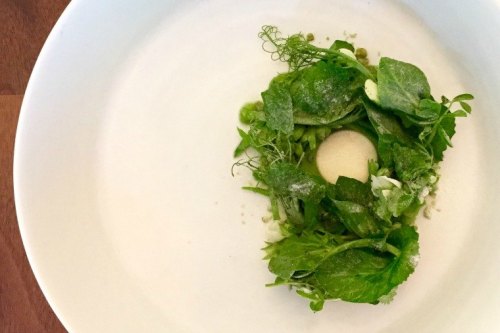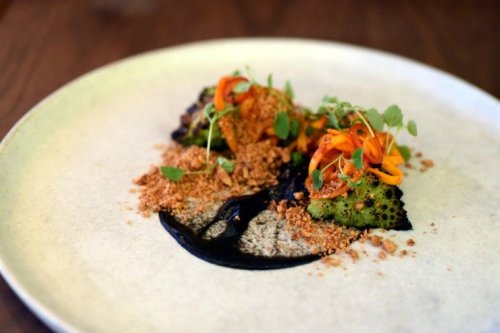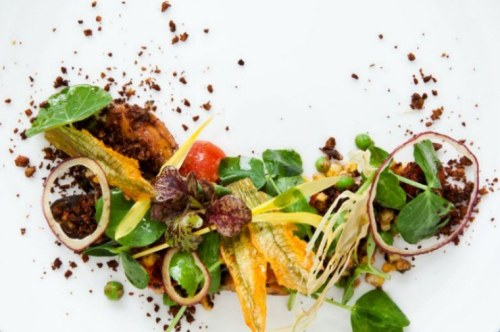Eat your veggies. It’s a phrase we heard over and over as kids. (And continue to hear as adults!) Luckily, thanks to a new generation of chefs, plant-based cooking has never looked or tasted better.
“Cooking vegetables is the wave of the future,” says Christopher Cipollone, executive chef of Piora in New York City. He should know: The Michelin-starred chef has been called a “vegetable shaman” because of his ability to work magic on leafy greens, root vegetables, and stalks, transforming them into works of culinary art. In fact, so many diners were asking for vegetarian dishes that he created a new garden-inspired prix fixe menu at Piora, spotlighting the season’s best market produce.
“We’re doing new things with what’s out there,” he says. “I get [inspiration] from everyday things. If I walk through a park and I see a flower bed arranged in a certain way I think, how can we achieve something that looks like that and tastes delicious?” Take the restaurant’s market salad: a combination of pickled, poached, roasted, dried, and raw veggies on top of a caramelized Jerusalem artichoke “soil” and Thousand Island-like dressing. It’s a far cry from that container of wilted mesclun mix sitting in your fridge.
But you don’t need to be the chef at a New York Times-approved restaurant to serve up delicious veggies—especially if you know how to approach your farmers’ market haul with a gourmet eye.
Ready to elevate your green game at home? Chef Cipollone shares his 4 tips for transforming your veggies to haute cuisine.

1. Buy from the source
While Cipollone has the culinary training to know what’s in season week to week, you can go directly to the source at your local farmers’ market. “Talking to the farmers is definitely the way to go,” says the chef. “They’re more than happy to talk about their product. They’re so proud of it.”
Ask them what’s good right now and what their highest-quality veggies are for that day. “If you make the extra effort, it’s worth it. That carrot from the farmers’ market is going to taste a lot better than the carrot that’s been sitting in a plastic bag at the grocery store,” he says.

2. Think like a meat-eater
Vegetables don’t have to be just a side dish—instead, let them get star billing. “If you look at it like the meat [of the dish], it’s a cool way to interpret the vegetable,” says Cipollone.
One way to do that? Cook the vegetable whole. Cipollone likes grilling an entire head of cauliflower slowly on low heat. “That will concentrate and pull out a lot of flavor from the cauliflower,” says Cipollone. A tandoori version, for example, plays up cauliflower’s natural match with Indian spices. (Just season the cauliflower with curry powder, a little yogurt, and lemon juice before putting it on the grill. says the chef.) Once it’s done, slice and serve like meat.
Another amazing idea from Cipollone: Bake large root vegetables like rutabaga and celery root whole (like you would a whole fish, by coating it with salt and pepper) and then turn them into a sausage-like ragu, served over rigatoni. “[The dish] really treated the vegetable like the meat, and it even had the texture of it because the salt crust really concentrated the flavors,” he says.

3. Play with your food
While your mom may not have liked it when you played with your food as a kid, experimenting is the key to developing your culinary skills as an adult (and it’s what Cipollone expects of the chefs in his kitchen). “Can it be raw, roasted, grilled, poached, and picked? Are there scraps you can make into a puree?” he asks. “If you have a little extra time and you really think about it, you can come up with some cool stuff.”
That goes for seasonings, too. “That’s where you look to different ethnic cuisines, where there are different spices and flavor profiles,” advises Cipollone. So go on, grab the turmeric, garam masala, and harissa from your spice rack.
And when in doubt? Pickle it! “We pickle everything from butternut squash to ramps to cauliflower,” says Cipollone. Not only does preserving let you treat yourself to out-of-season vegetables (hello, ricotta on toast with picked ramps in the middle of winter!) but it allows you to add serious flavor to a dish. “You can pinpoint and add bursts of acidity where you want on a dish,” he says.

4) Don’t go for looks
While it’s hard to resist the bright and picture-perfect fruits and vegetables at the market, don’t overlook the “ugly” vegetables.
“There’s a difference between ugly and rotten. When we’re talking about ugly we’re talking about the non-uniform, like a parsnip that’s grown in two different ways,” says Cipollone. The chef jumps at opportunities to use these organic vegetables, and not just to reduce food waste. He believes non-uniform ingredients lend themselves to cool presentations and flavors. “Sometimes a carrot is fatter on one end and really small on the other. There might be two different textures when you cook it.”
And anything that looks interesting enough to take a picture—what could be more restaurant-like than that?!
BTW, do you know the healthiest way to cook vegetables? And if you really want to mix it up, veggie-wise, here’s a guide to “it” (sea) green, seaweed—recipes included.
Sign Up for Our Daily Newsletter
Get all the latest in wellness, trends, food, fitness, beauty, and more delivered right to your inbox.
Got it, you've been added to our email list.











